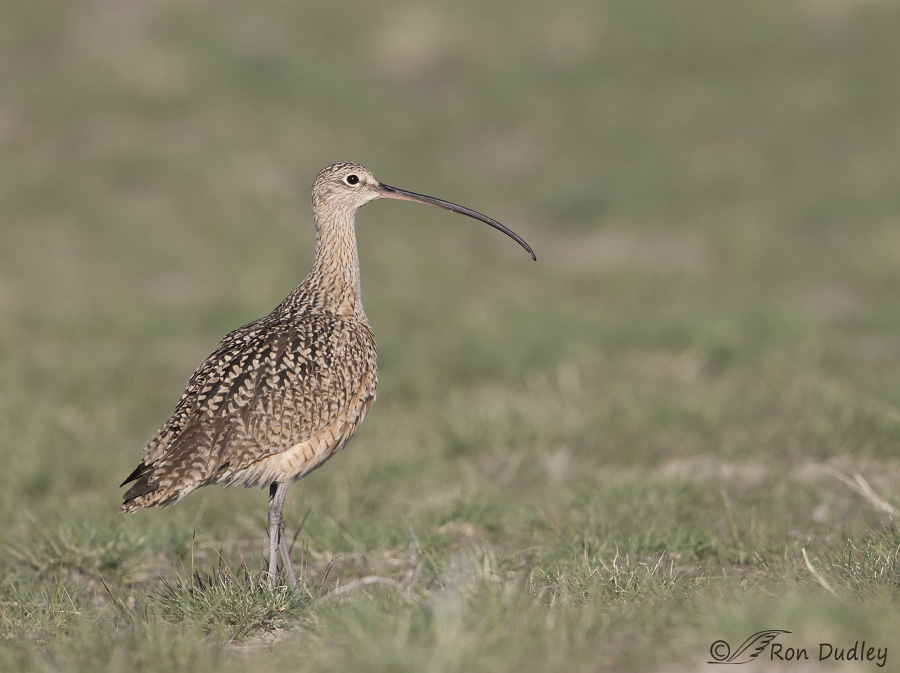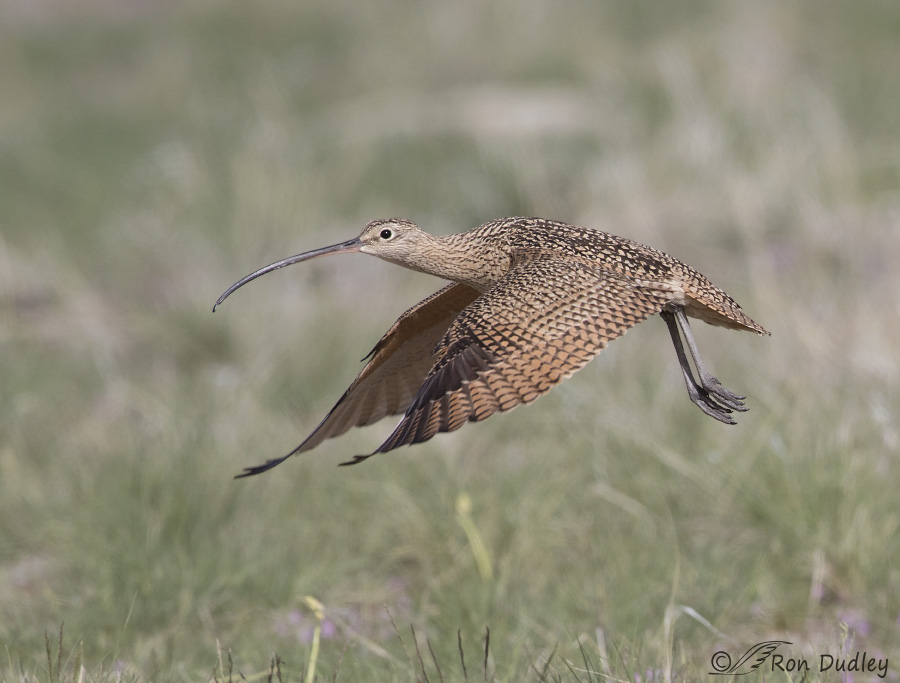I’m tired of blurry images of curlews taking off so I’m trying a new tack.

1/2500, f/6.3, ISO 500, Canon 7D Mark II, Canon EF 500mm f/4L IS II USM + 1.4 tc, not baited, set up or called in
I love photographing Long-billed Curlews in the spring after they’ve returned from migration but they present a somewhat unusual challenge when taking off. They’re large, relatively heavy-bodied birds so when they launch from the ground they typically squat down for an instant so they can use their long legs to help push them into the air. When they do it they squat so low that their belly almost touches the ground and their head and neck are also lowered.
So here’s the problem. Imagine that you have your lens trained on this long-necked and long-legged bird and its body language tells you it’s about to take off. Your active focus points are locked onto its head/neck area and you’re ready to go when the bird is. But an instant before it launches it squats down to push off and when it does you lose focus on the bird and lock on to the background instead. You miss the most dramatic wing positions because the bird is soft in those shots. If you’re lucky (very lucky if the background is close to the bird) you can reacquire sharp focus as the bird flies away but some of your best opportunities are already history.
Time and time again that’s happened to me with curlews and I’m tired of it.

1/3200, f/7.1, ISO 500, Canon 7D Mark II, Canon EF 500mm f/4L IS II USM + 1.4 tc, not baited, set up or called in
And it’s exactly what happened with this curlew yesterday morning on Antelope Island. I was locked on before takeoff, it squatted and I lost focus, so the most dramatic shots at takeoff were soft. I was only able to reacquire sharp focus for this one shot.
So, I’m going to try two new strategies depending on the situation:
- Curlews nearly always take off in the direction they’re facing. If that direction is at a 90 degree angle to me (like it was with this bird), which theoretically will keep it in the same focal plane as when it was perched, I’ll lock onto the bird just before launch and take my thumb off the focusing button (I use back button focus) just before it’s likely to launch. That way I don’t lose focus on the bird when it squats and I have a good chance of getting the first few takeoff shots sharp. Then I can also attempt to lock back onto the bird as it flies away.
- If it’s facing me at an oblique angle when it launches I’ll try using more (5) active focus points trained on its belly and chest (which should reduce the chances of losing focus when it squats) and try to maintain focus throughout the takeoff process.
- If the bird is facing away from me I’ll just pick my nose and not worry about it. I already have enough butt shots.
Anyway, these are going to be my strategies for now. We’ll see how it turns out.
Apologies to non-photographers for another photogeek post. Hopefully you can at least enjoy the second image. I know I do.
Ron


Very useful advice on not pressing the AF button when the bird is about the take off.
Cracked me up about what you’d do when they face away.
Great Curlew flight shot and I love Elephant’s Child’s “juxtapositon of butt shots and picking your nose is not a comfortable one…”
Great photos and thank you for sharing your info. Would this be a good time to use back button focus to keep the focus point on the bird and then use the shutter to take the shot? thanks again.
Leo, that’s my normal M.O. for this situation but when the bird squats I typically lose my lock on the bird since there usually isn’t much warning. I could follow the bird down but then I clip wings when it raises them. There’s just so many options and none of them have worked well for me yet…
Ron: Very nice shots as usual. I agree with Trudy…I think you could make anything look good. The sharpness and detail on all of your photos is amazing. As is the tonal range…you have great, deep colors on your pics…nothing washed out. I’ll be interested to see how this new techniques works for you.
So will I, Zaph, though it may take me a while to find out because we have bad weather coming in tomorrow afternoon. Maybe there’ll be a little light in the morning before it hits…
The juxtapositon of butt shots and picking your nose is not a comfortable one…
My decidedly non-technical self is always happy for a photo-geek post. Perhaps (if I am lucky) I will absorb some of your tips through osmosis.
Love the graceful curves that the curlew rocks so well.
Yuck, never thought of that, EC…!
Great shot Ron! Good tip, I will try it. Hopefully it will work with any shorebird.
Dick, If it were me I probably wouldn’t resort to these new strategies if the bird wasn’t a long-legged, long-necked bird that always crouched low before it took off. And for the birds I shoot the curlew is the prime candidate.
I love the images you caught of this interesting, graceful looking bird…and got a big laugh out of your comment about butt shots–and picking your nose…
Both shots are beautiful…especially like the second–find it unusual and interesting…particulary like the position of the wings and feet and the outstretched neck…
Good. I’m always happy to make folks laugh, Patty!
Great observations Ron. Sounds like a solid approach to me. Let us know how it works out as I know I and I’m sure others struggle with the same problems. Love the shots you got.
Larry, I’ll probably mention whether or not the new strategies work in later curlew posts. Thanks.
I think your photos are great no matter what! Don’t sweat the little stuff. lol Lots of Laughs
Thank you, Trudy.
I use the star button on back of 7D2 (next to AF point select button) to lock focus when in AIServo Mode). So hold the * button (focus locked), then let go when take off. Done.
Rich
Richard, I use the AF-ON button, right next to the star button.
Thanks so much for the photography tips, Ron – especially for us newbies to bird photography!! As for your Curlew photos, I thing they are terrific – especially the in-flight capture. The curlew is another of those unique, interesting birds you share with us – Thanks again!!
You’re certainly right about the curlew being unique, Jo Ann – that incredible bill is just so very different from that of nearly all other birds.
Still a good shot.
Charlotte
Thanks, Charlotte.
Sounds like it’s worth a try since the odds are they’ll do the squat first! Will take some retraining of muscles and mind, BUT!
Will take some retraining of muscles and mind, BUT!  I haven’t worked with the back button focus yet. Nice shots – they are beautiful birds.:)
I haven’t worked with the back button focus yet. Nice shots – they are beautiful birds.:)
Judy, I highly recommend back button focus for birds. I believe that if you give it a go you’ll never look back.
Ron that is what I do waiting for the bird to take off get more keepers
Good to know, Myer.
Seems to me that your new strategy has feet to go on successfully but I wonder how do you change from one active focus point to five in a split second?
Great catch.
Thanks for today’s and yesterday tips.
Jorge, it probably takes me about a second to change active focus points but as you know that’s a very long time in this situation. Thankfully I can often read from their behavior that they’re about to take off so I’ll hopefully have enough time to change them before that happens. We’ll see, I’ll have to play with it and see how well it works.
Great images, Ron. Thanks for the photo tip too.
You’re welcome, Alan. Thanks.